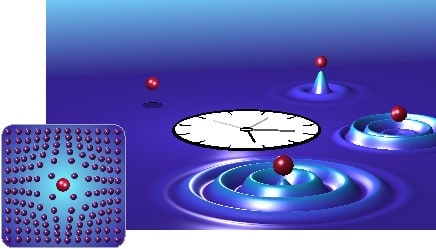Ultracold atoms permit direct observation of quasiparticle dynamics
18 Mar 2021 Oliver Stockdale
Theories of how quasiparticles form have been around for more than 80 years, but direct observations of the process have remained elusive due to experimental challenges. A team of researchers at the Center for Complex Quantum Systems, Aarhus University, Denmark has recently overcome these obstacles by studying quasiparticle formation and dynamics in ultracold atoms.
The Soviet physicist Lev Landau developed a theory of quasiparticles – emergent phenomena that arise from a complex interaction between many real particles – in the 1930s. This theory, which is still routinely used in practical applications ranging from superconductivity to transport processes in electronic devices, considers the motion of an electron through a solid and describes how the electron (the quantum impurity) triggers the formation of a quasiparticle within the solid.
An ultracold analogue
Due to the high densities and fast timescales of this system, however, experiments cannot directly probe such quasiparticle behaviour in solids. The Aarhus team instead studied an analogue system: a quasiparticle called a polaron in a Bose-Einstein condensate (BEC). This dilute gas of ultracold atoms offers a pristine, controlled environment in which to study the quantum dynamics of many-body phenomena. Simulation centre: The region of the Aarhus experiment where atoms are initially trapped and cooled. (Courtesy: Lars Kruse/AU foto)
Simulation centre: The region of the Aarhus experiment where atoms are initially trapped and cooled. (Courtesy: Lars Kruse/AU foto)
 Simulation centre: The region of the Aarhus experiment where atoms are initially trapped and cooled. (Courtesy: Lars Kruse/AU foto)
Simulation centre: The region of the Aarhus experiment where atoms are initially trapped and cooled. (Courtesy: Lars Kruse/AU foto)“Quasiparticles are exceedingly interesting to study since they may be composed by numerous particles and their excitations,” explains lead author Magnus Skou, a PhD student at Aarhus. “The Bose polaron is an excellent example of such a challenging quasiparticle that nonetheless holds great potential for helping us to understand exotic technologies like organic semiconductors and superconductors. This inspired us to investigate the polaron in an ultracold cloud of atoms and, in particular, to see if we could observe its gradual formation.”
Witnessing the formation of a Bose polaron
The team created the impurity not with an electron, but by manipulating the quantum state of only a few atoms in the BEC. Through theoretical modelling of the system, the authors identified three different dynamical regimes to describe the state of the impurity. By tuning the interaction strength of the atoms in the condensate and evolving the experiment for different lengths of time, the group experimentally probed each of these regimes. Their experiments, which Skou and fellow co-author Kristian Nielsen describe in a video posted to Twitter, showed how the impurity gradually evolved to form the polaron.READ MORE

Skou predicts that their experiments offer promising pathways to better understand the interactions between quasiparticles. “Now that we have a better understanding of polarons,” he says, “it will be interesting to study how they interact with each other. These intricate interactions were recently predicted to enable the formation of a completely new quasiparticle known as a bipolaron. This quasiparticle has not yet been observed in an ultracold atomic gas, but we now believe that our experiment may allow for it to finally be seen.”
The research is described in Nature Physics.
FROM PHYSICSWORLD.COM 22/3/2021

Δεν υπάρχουν σχόλια:
Δημοσίευση σχολίου